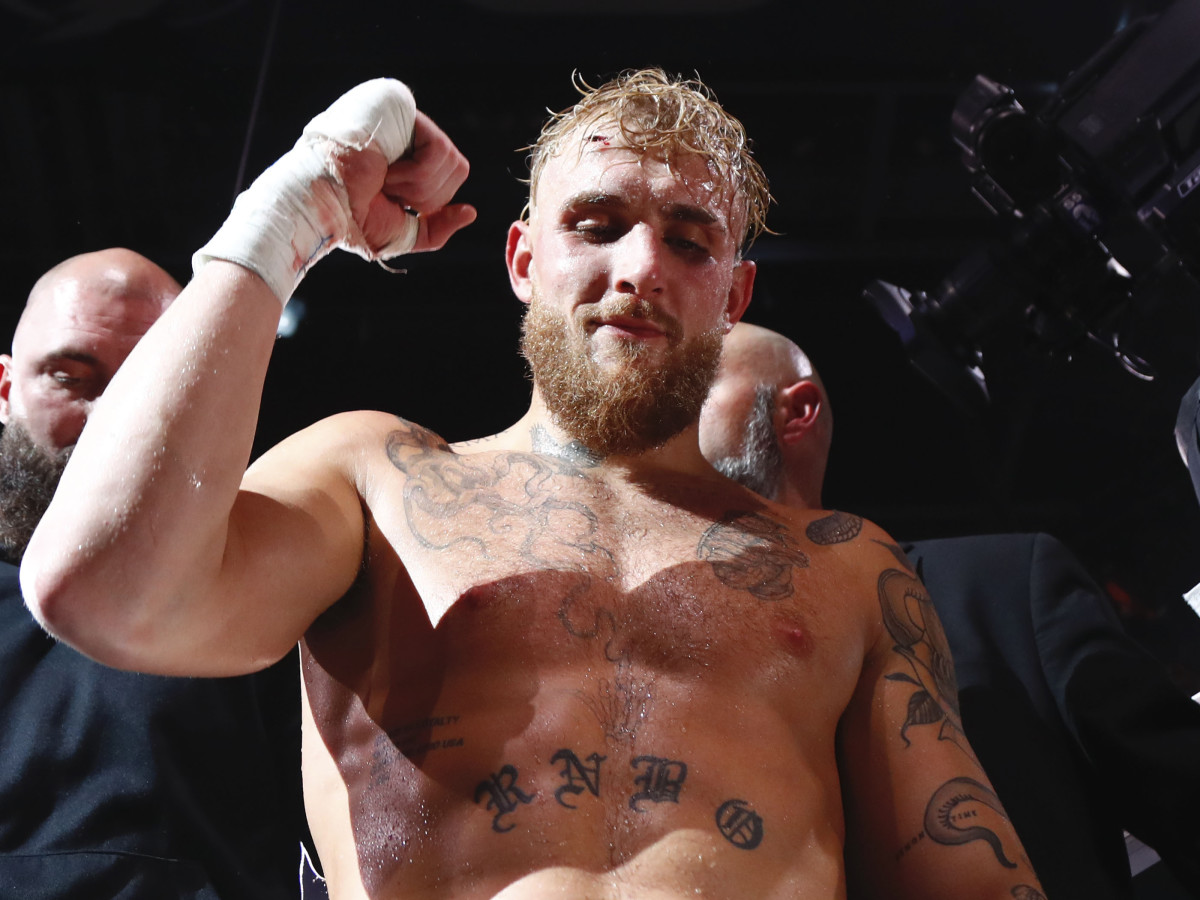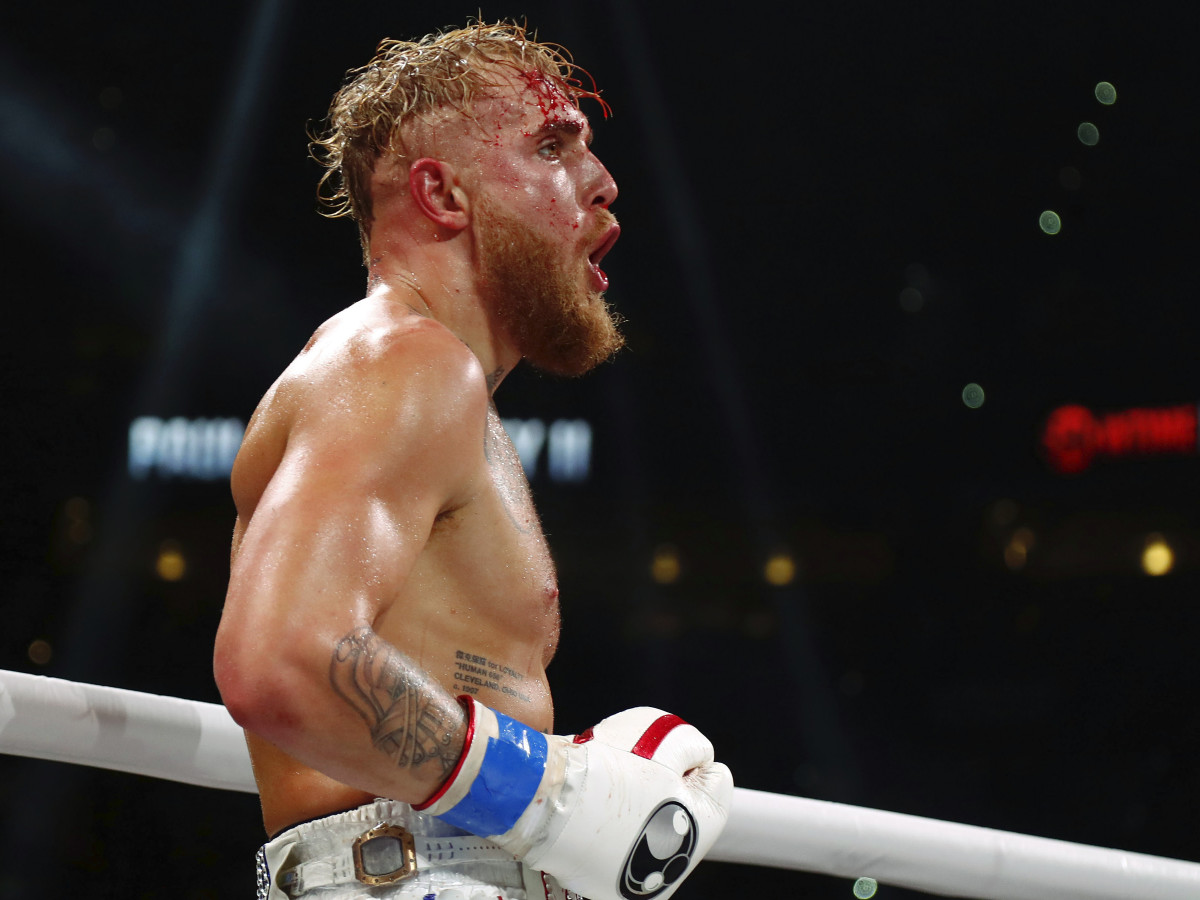Jake Paul Is Sports Illustrated’s 2021 Breakout Boxer of the Year

Jake Paul isn’t chasing championships, no matter how much you want him to, no matter how many times you scream that it’s the only way to validate him. He isn’t rushing to fight “real boxers,” as Claressa Shields, Tony Bellew and Sergio Mora have suggested. He doesn’t care if you call him a “Disney kid” (Kamaru Usman) or urge Paul, 24, to fight guys his own age (Dana White). “An experienced fighter in his own weight class will demolish him,” Bob Arum said recently. Good thing Jake has no firm plans on facing one.
Why not? Better question: Why would he? In one year, Paul has emerged as one of boxing’s biggest attractions. He has three wins, two by knockout, one by spectacular knockout. He has packed arenas in Ohio and Florida. He has reportedly generated more pay-per-view buys this year than any non-heavyweight not named Canelo. He has marshaled his social media following—20.4 million on YouTube, 18.4 million on Instagram and 15.7 million on TikTok—to create an army of boxing fans that never existed. He is Sports Illustrated’s Breakout Boxer of the Year not for his potential, but for what he already is.
“To think about how all the things that happened in the fashion that it all happened,” Paul told SI this week, “it's just sort of mind-blowing.”

Paul’s year began in April, against Ben Askren, a cocky ex-UFC grappler who dismissed Paul as a sideshow. Less than two minutes into the first round, a wobbly Askren, flattened by a looping right hand, thought something different.
In August, it was Tyron Woodley, the menacing ex-UFC champion regarded by some as the greatest welterweight mixed martial artist of all time. Woodley was game, pressuring Paul, wearing down a fighter who had never gone past the second round by stretching him to eight. In the end, though, Paul did enough to earn a split decision.
In December, Woodley was back, this time as a late replacement for Tommy Fury, the celebrity boxer and brother of heavyweight champion Tyson Fury who withdrew with an injury. This time, Paul left little doubt, detonating a right hand on Woodley’s skull in the fifth round, sending him face first to the canvas. In the aftermath, Woodley acknowledged Paul’s talent. “At some point,” Woodley said, “We’re going to have to put a little respect on Jake’s name.”
WHAT A SHOT. @jakepaul KOs Woodley in round 6 😳#PaulWoodley pic.twitter.com/oTV3xeNtfg
— All the Smoke Boxing (@atsboxing) December 19, 2021
Respect isn’t coming, at least not from boxers. “I’m polarizing, right?" Paul said. Indeed.
The boxing universe is a paradox. There are no barriers to entry, but those in it insist true success can only be achieved through an outdated archetype. Ten fights against opponents on X level, 10 more with fighters on Y, before eventually challenging for titles that lose relevance by the year. Social media muscle has blown a hole through that model, and Paul stepped right through it. As Mike Tyson said on his podcast, boxers “see this little white guy, blond-haired, blue-eyed making all this f---ing money, talking all this s---. Everybody wants to kill him.”
Critics see Paul as an interloper, but that’s not accurate, either. “He takes the sport more seriously than anyone I have ever seen,” says Paul’s trainer, B.J. Flores. Flores, an ex-cruiserweight contender, sparred with Paul in 2020, when Paul was preparing for his pro debut. He became Paul’s coach soon after, spending months with Paul in Las Vegas. Each morning, says Flores, the two would dive into film. Andre Ward. Wladimir Klitschko. Roy Jones. Evander Holyfield. “He’s a student of the game,” says Flores. Where skeptics, like Shields, saw the punch that stopped Woodley as lucky, Flores saw it as a result of serious training. “He set up Tyron for that shot,” says Flores. “He’s got great focus. And he will not be outworked.”
Paul’s opponents aren’t world beaters, but five fights into a pro career, whose are? Canelo Alvarez, boxing’s pound-for-pound king, needed four fights to face an opponent who possessed a win. Ten of Terence Crawford’s first 12 opponents had losing records. Two of Gervonta Davis’s first three wins came against fighters making their pro debuts. Woodley isn’t a traditional boxer. But he’s probably more dangerous than Evincii Dixon, a 7-14-1 welterweight Josh Taylor faced in his sixth fight as a pro.
Moreover, Paul is elevating boxing. Not through his fights, but through the visibility traditional boxers showcased on his cards receive. “Everyone around him gets lifted up,” says Flores. Montana Love was an unheralded junior welterweight prospect before he appeared on the undercard of Paul’s first fight with Woodley. A knockout win over Ivan Baranchyk earned Love a multifight deal with Matchroom. Amanda Serrano was a seven-division world champion before she met Paul. Back-to-back wins on Paul’s undercards boosted her Q-rating—and her bank account. Tweeted Serrano last month, “I just realized I’m officially a millionaire!”

Paul won’t win over many in boxing, but he doesn’t have to. He has an audience, and it’s growing. Opponents continue to line up, and Showtime is standing behind him. Tommy Fury held a press conference after Paul’s win over Woodley daring Paul to reschedule. Paul isn’t interested. “I’d rather fight [Fury’s father] John,” Paul said. He called a fight against ex-middleweight champion Julio Cesar Chavez Jr. “interesting” and says he would love to lure Mike Tyson back into the ring. And he knows that non-boxers like Jorge Masvidal, Nate Diaz, even Buccaneers running back Le’Veon Bell will want a piece.
His promotional company, Most Valuable Promotions, will continue to run his fights, but they will be involved with others, too. Paul signed Serrano to MVP and his team is in negotiations with Eddie Hearn to match Serrano and Katie Taylor sometime this spring. Taylor-Serrano was already the biggest fight to be made in women’s boxing. Even Hearn admits Paul’s presence makes it bigger.
Hate Jake Paul all you want, but make no mistake: He isn’t going anywhere. “I feel like I just finished my rookie season,” says Paul. He has largely stepped away from making YouTube videos, in part to focus more on boxing but also because he was accused of sexual assault early last year (Paul has denied the allegation). Boxers bemoan his existence but the truth is boxing created it, with its steady diet of mismatches and $80 pay per views. It created an opportunity for someone like Paul—and he seized it, vowing more is still to come.
“It's going to be really hard to change the business model of boxing,” says Paul. “But I think at least what I'm showing is how someone can do it.”
More Boxing Coverage:
